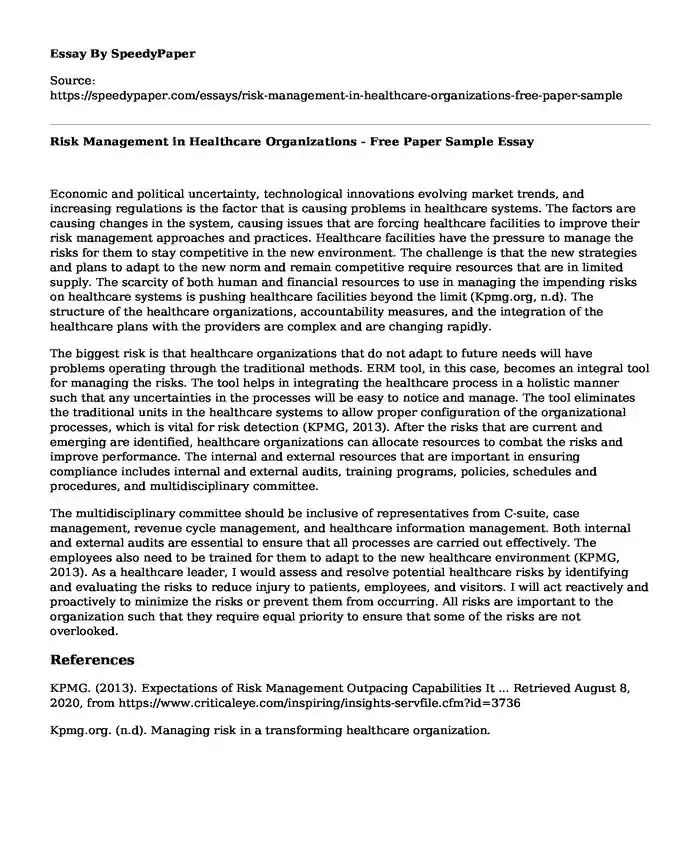
| Type of paper: | Essay |
| Categories: | Healthcare Risk management |
| Pages: | 2 |
| Wordcount: | 421 words |
Economic and political uncertainty, technological innovations evolving market trends, and increasing regulations is the factor that is causing problems in healthcare systems. The factors are causing changes in the system, causing issues that are forcing healthcare facilities to improve their risk management approaches and practices. Healthcare facilities have the pressure to manage the risks for them to stay competitive in the new environment. The challenge is that the new strategies and plans to adapt to the new norm and remain competitive require resources that are in limited supply. The scarcity of both human and financial resources to use in managing the impending risks on healthcare systems is pushing healthcare facilities beyond the limit (Kpmg.org, n.d). The structure of the healthcare organizations, accountability measures, and the integration of the healthcare plans with the providers are complex and are changing rapidly.
The biggest risk is that healthcare organizations that do not adapt to future needs will have problems operating through the traditional methods. ERM tool, in this case, becomes an integral tool for managing the risks. The tool helps in integrating the healthcare process in a holistic manner such that any uncertainties in the processes will be easy to notice and manage. The tool eliminates the traditional units in the healthcare systems to allow proper configuration of the organizational processes, which is vital for risk detection (KPMG, 2013). After the risks that are current and emerging are identified, healthcare organizations can allocate resources to combat the risks and improve performance. The internal and external resources that are important in ensuring compliance includes internal and external audits, training programs, policies, schedules and procedures, and multidisciplinary committee.
The multidisciplinary committee should be inclusive of representatives from C-suite, case management, revenue cycle management, and healthcare information management. Both internal and external audits are essential to ensure that all processes are carried out effectively. The employees also need to be trained for them to adapt to the new healthcare environment (KPMG, 2013). As a healthcare leader, I would assess and resolve potential healthcare risks by identifying and evaluating the risks to reduce injury to patients, employees, and visitors. I will act reactively and proactively to minimize the risks or prevent them from occurring. All risks are important to the organization such that they require equal priority to ensure that some of the risks are not overlooked.
References
KPMG. (2013). Expectations of Risk Management Outpacing Capabilities It ... Retrieved August 8, 2020, from https://www.criticaleye.com/inspiring/insights-servfile.cfm?id=3736
Kpmg.org. (n.d). Managing risk in a transforming healthcare organization.
Cite this page
Risk Management in Healthcare Organizations - Free Paper Sample. (2023, Nov 08). Retrieved from https://speedypaper.com/essays/risk-management-in-healthcare-organizations-free-paper-sample
Request Removal
If you are the original author of this essay and no longer wish to have it published on the SpeedyPaper website, please click below to request its removal:
- Essay Example on Medical Research Methodology
- Essay Sample: Competitive Ability to Acquire Surgical Robot Unit
- Essay Example on Practicum: Health Disparities
- 5-Year Professional Plan: Healthcare Goals for Career Growth - Essay Sample
- Research Paper on Tap Water vs. Normal Saline for Wound Healing in Adults
- Healthcare Abuse and Fraud: Prosecution, Protection and Prevention - Essay Sample
- Paper Sample on Intel's Ethical Challenge: Addressing Human Rights Concerns in the Coltan Supply Chain
Popular categories




